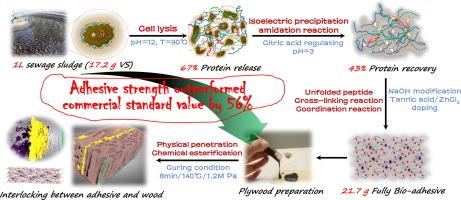Sewage Sludge Protein-based Fully Bio-Adhesive for Plywood
IF 11.6
1区 工程技术
Q1 ENGINEERING, MULTIDISCIPLINARY
引用次数: 0
Abstract
To advance sewage sludge (SS) valorization, this study proposed a novel approach that integrated protein recovery from SS with its conversion into a fully bio-based adhesive for plywood production. A thermal-alkaline pretreatment (pH = 12, 90 ℃) followed by acidic precipitation enabled efficient recovery of sewage sludge protein (SSP). Compared to the commonly used sulfuric acid, citric acid partially co-precipitated with SSP, potentially promoting amidation reactions between amino and carboxyl groups during the curing process. This interaction contributed to the enhanced adhesive strength of SSP. Inspired by the catechol-mediated adhesion mechanism of mussel foot proteins, tannic acid (Tan) and Zn2+ ions were incorporated into the alkali-modified SSP. Covalent and hydrogen bonding occurred through cross-linking between the polyphenolic moieties of Tan and the amide/carbonyl groups of SSP, while Zn2+ ions served as coordination centers, further strengthening interfacial cohesion. These procedures reassembled the fragmented peptide chains of SSP, resulting in enhanced hydrophobicity, thermal stability, and mold resistance. Under optimized curing conditions (140 ℃, 8 min), the resulting adhesive achieved a wet shear strength of (1.09 ± 0.08) MPa, surpassing the Chinese National Standard (≥ 0.7 MPa) by 55.7%. X-ray micro-computed tomography revealed that 24.1% of the adhesive penetrated the wood micropores during curing, with mechanical interlocking complementing bulk adhesion to improve shear performance. Heat-induced structural reorganization further promoted β-sheet formation and esterification between SSP peptides and Tan, thereby reinforcing the adhesive’s cross-linked architecture. Finally, a preliminary assessment of the process’s economic viability and carbon neutrality potential highlighted its promise for sustainable, engineering-scale implementation.

污泥蛋白基胶合板全生物胶粘剂
为了促进污水污泥(SS)的增值,本研究提出了一种新的方法,将SS中的蛋白质回收与转化为用于胶合板生产的全生物基粘合剂结合起来。采用热碱性预处理(pH = 12, 90℃)后进行酸性沉淀,可有效回收污泥蛋白(SSP)。与常用的硫酸相比,柠檬酸与SSP部分共沉淀,在固化过程中可能促进氨基和羧基之间的酰胺化反应。这种相互作用有助于提高SSP的粘接强度。受儿茶酚介导的贻贝足蛋白粘附机制的启发,将单宁酸(Tan)和Zn2+离子掺入碱修饰的SSP中。Tan的多酚基团与SSP的酰胺/羰基之间通过交联形成共价键和氢键,Zn2+离子作为配位中心,进一步增强了界面的内聚性。这些过程重新组装了SSP的片段肽链,从而增强了疏水性,热稳定性和抗霉菌性。在优化的养护条件下(140℃,8 min),得到的胶粘剂湿抗剪强度为(1.09±0.08)MPa,比中国国家标准(≥0.7 MPa)高出55.7%。x射线显微计算机断层扫描显示,在固化过程中,24.1%的胶粘剂渗透到木材微孔中,机械联锁补充了体粘接,提高了剪切性能。热诱导的结构重组进一步促进了SSP肽与Tan之间的β-薄片形成和酯化反应,从而增强了粘合剂的交联结构。最后,对该工艺的经济可行性和碳中和潜力的初步评估强调了其可持续的、工程规模的实施前景。
本文章由计算机程序翻译,如有差异,请以英文原文为准。
求助全文
约1分钟内获得全文
求助全文
来源期刊

Engineering
Environmental Science-Environmental Engineering
自引率
1.60%
发文量
335
审稿时长
35 days
期刊介绍:
Engineering, an international open-access journal initiated by the Chinese Academy of Engineering (CAE) in 2015, serves as a distinguished platform for disseminating cutting-edge advancements in engineering R&D, sharing major research outputs, and highlighting key achievements worldwide. The journal's objectives encompass reporting progress in engineering science, fostering discussions on hot topics, addressing areas of interest, challenges, and prospects in engineering development, while considering human and environmental well-being and ethics in engineering. It aims to inspire breakthroughs and innovations with profound economic and social significance, propelling them to advanced international standards and transforming them into a new productive force. Ultimately, this endeavor seeks to bring about positive changes globally, benefit humanity, and shape a new future.
 求助内容:
求助内容: 应助结果提醒方式:
应助结果提醒方式:


